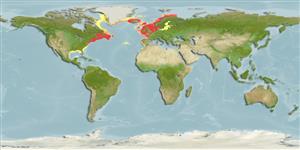Environment: milieu / climate zone / depth range / distribution range
Ecologie
marien demersaal; oceanodroom (Ref. 51243); diepte 20 - 650 m (Ref. 6144), usually 20 - 50 m. Temperate; 73°N - 20°N, 99°W - 32°E (Ref. 1371)
Eastern Atlantic: from Norway, Greenland and Iceland south to British Isles and northern Bay of Biscay, including the North Sea and the southern Baltic Sea (70°N to 20°N). Western Atlantic: from Greenland to northern Gulf of Mexico (Ref. 125219). Reported from Estonia (Ref. 33247).
Lengte bij maturiteit / Grootte / Gewicht / Leeftijd
Maturity: Lm 25.0, range 15 - ? cm
Max length : 41.0 cm TL mannelijk / geslacht onbekend; (Ref. 1371); common length : 30.0 cm TL mannelijk / geslacht onbekend; (Ref. 1371); max. gerapporteerde leeftijd: 9 Jaren (Ref. 1371)
Dorsale stekels (totaal) : 0; Anale stekels: 0. One barbel on chin, one on tip of snout, and one at each of the anterior nostril. First dorsal fin ray very elongate, followed by a row of small, fleshy filaments. Color varies from dusky to pale.
Sedentary bottom dwellers on muddy sand between patches of hard substrate, or on the soft, smooth ground of deep sinks on the continental slopes of both sides of the North Atlantic. Feed on flatfishes, amphipods, decapods, copepods, mysids, shrimps, isopods and other small crustaceans. Spawn in the Baltic Sea (Ref. 35388). Mixed with soups and other products hot-smoked (Ref. 1371).
Spawning has been recorded in waters less than 140 m deep. Fecundity ranges from 5,000 - 45,000.
Cohen, D.M., T. Inada, T. Iwamoto and N. Scialabba, 1990. FAO species catalogue. Vol. 10. Gadiform fishes of the world (Order Gadiformes). An annotated and illustrated catalogue of cods, hakes, grenadiers and other gadiform fishes known to date. FAO Fish. Synop. 125(10). Rome: FAO. 442 p. (Ref. 1371)
Status op de Rode Lijst van het IUCN (Ref. 130435)
Gevaar voor de mens
Harmless
Gebruik door de mens
Visserij: van minder commercieel belang
Tools
Speciale rapporten
Download XML
Internetbronnen
Estimates based on models
Preferred temperature (Ref.
123201): 4.1 - 13.8, mean 10 °C (based on 715 cells).
Fylogenetische diversiteitsindex (Ref.
82804): PD
50 = 1.0000 [Uniqueness, from 0.5 = low to 2.0 = high].
Bayesian length-weight: a=0.00407 (0.00242 - 0.00685), b=3.06 (2.92 - 3.20), in cm total length, based on LWR estimates for this species & (Sub)family-body (Ref.
93245).
Trofisch niveau (Ref.
69278): 3.5 ±0.0 se; based on diet studies.
Weerstandsvermogen (Ref.
120179): Gemiddeld, minimale populatieverdubbelingstijd 1,4-4,4 jaar (K=0.20-0.25; tm=3; tmax=9; Fec=5,000).
Fishing Vulnerability (Ref.
59153): Moderate to high vulnerability (46 of 100).
Climate Vulnerability (Ref.
125649): Low vulnerability (6 of 100).
Nutrients (Ref.
124155): Calcium = 38.2 [18.6, 84.5] mg/100g; Iron = 0.329 [0.174, 0.696] mg/100g; Protein = 17.1 [15.4, 18.9] %; Omega3 = 0.42 [0.22, 0.77] g/100g; Selenium = 20.1 [10.3, 42.2] μg/100g; VitaminA = 13.6 [3.2, 52.4] μg/100g; Zinc = 0.564 [0.390, 0.882] mg/100g (wet weight);
